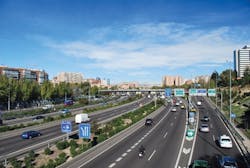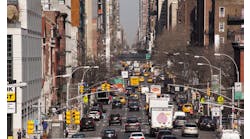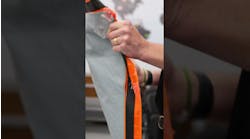By: Ken Philmus
In 1903, Dr. Horatio Nelson Jackson became the first person to cross the U.S. by automobile. The trip took the Vermont physician 65 days in a 20-hp Winton, raising dry clouds of dust and chugging through axle-deep mud on mostly unpaved roads. Not until the 1930s could a vehicle cross the nation coast-to-coast on paved highways.
Today, the Dwight D. Eisenhower System of Interstate and Defense Highways comprises nearly 50,000 miles of paved multilane highways, bridges, tunnels and toll roads. As the largest highway network in the world and one of the greatest public-works projects in human history, the system symbolizes America’s finest qualities: innovation and ingenuity.
As fast as the highway system has grown, cities have grown even faster. Today, transportation routes too often symbolize not America’s progress but its modern problems: congestion, fuel waste, crumbling infrastructure. Before our very eyes, the world’s finest surface-transportation network, a great stimulant of American economic growth, suddenly appears as if it is becoming a barrier to progress.
What is the greatest risk to the nation’s surface-transportation system today? It is funding. Transportation infrastructure is in a funding mess. Most of the revenue required to operate, maintain, manage and—perhaps most important these days—to preserve the nation’s roadway systems comes from local, state and federal fuel taxes, and collections haven’t changed much at all in many years and are, in fact, declining.
Vehicles are attaining better fuel efficiency, which is essential to protecting our energy resources and environment, and are utilizing alternate fuels. This increasingly efficient way that we are using traditional fuels means less fuel-tax revenue. In addition, we can expect increased productivity on the horizon with growing Corporate Average Fuel Economy (CAFE) standards. At the same time there have been major increases in fuel prices, contributing to an even greater loss of total vehicle-miles traveled and ultimately the amount of fuel tax collected.
So, while transportation infrastructure needs are increasing—and in some cases exponentially as the nation’s infrastructure ages beyond its useful life—there is less revenue being generated for the preservation and upkeep of our roadways, bridges and tunnels.
This is an unsustainable situation.
The nation is gridlocked at the federal level and cannot seem to find its way out of the funding corner it backed itself into.
Where do we go from here?
As a former director of Tunnels, Bridges and Bus Terminals in the New York metropolitan region for the Port Authority of New York and New Jersey who had direct responsibility for maximizing mobility on some of the nation’s most congested facilities, I not only looked at the immediate and obvious traffic-management problems in front of me but I also focused on the future—knowing full well that the decades-old tunnels and bridges I was responsible for between New York and New Jersey had to be there for future generations. If the George Washington Bridge, the Lincoln and Holland tunnels, the Staten Island bridges and the New York bus terminals were not taken care of appropriately, economic vitality and social quality of life could not be maintained. Not to mention it would limit the New York-New Jersey region’s ability to compete with other regions across the U.S. and the world.
But during that time, tolling was our sure advantage. Tolling that could not only generate much-needed revenue, but tolling that also could be used as an economic means to manage ever-increasing traffic and congestion.
Pay to play
The revenues required to effectively protect the infrastructure were not dependent on declining fuel-tax revenue. Whether drivers were commuters, recreational travelers or freight movers, each one of them paid directly to use these facilities and support overall regional mobility. Tolling—at its most basic—is a user fee. As a result, we had dedicated revenues at the public facilities under our aegis, and therefore a dedicated capital program. This was in addition to needed operations and management funds.
Mileage-based user fees (MBUFs) are different from tolls—although some tolls are mileage-based—but ultimately they are both user fees. An economic decision is made every time a driver chooses a toll facility. Someone who needs to be somewhere at a certain time, and he or she decides that driving is the transportation of choice, consciously makes the determination that the benefit to use certain facilities is worth the expense. Drivers, for the most part, know that what they pay goes directly to taking care of the facilities they need to rely on to get from point A to point B.
One could say that tolling is the original MBUF. While there are issues in tolling, such as the important transition to national interoperability, which is not much different from the question of how a state-based MBUF can be rationalized across existing governmental lines, tolling technology has evolved. The traditional process of stopping at a booth, creating traffic backups and paying cash to use a facility is fast disappearing. In the past, tolling created congestion as necessary revenue was collected. While most people don’t like paying tolls, people really don’t like stopping to pay tolls. Today, tolling is eliminating congestion.
To be clear, tolling is not the ultimate, all-inclusive solution to our transportation-funding woes. However, it is undoubtedly part of the solution. And the technology is in a place where it has become much easier to implement. I have clearly witnessed this as I moved from directly managing one of the largest cash and electronically tolled public-facility systems in the U.S. to toll operations at Xerox, where we provide in-lane and back-office services to some of the busiest toll agencies in the U.S.—including a few that are now moving to all-electronic collection.
Because transportation-infrastructure funding solutions have difficulty emerging at the federal level, local and state entities need to have the flexibility to consider all revenue-generating options to meet their needs. With many states also having difficulty raising traditional fuel taxes, a MBUF is being considered and pilot-tested in several locations. Tolling, however, is still often the only viable funding source—whether funded directly by the agencies or through public-private partnerships.
Additionally, tolling clearly utilizes the “user-pays” philosophy that sits at the heart of MBUFs, which is to say that those who use the roads are the ones paying for them. Tying user fees directly to the miles driven by a vehicle matches a usage pricing model favored by many businesses. Turn on a light; you pay for the electricity you use. Cell-phone owners pay for the amount of data they use. TV aficionados pay extra for select shows. Drivers pay extra for electronic-toll transponders in cars that let them skip tollbooth lines.
If and when MBUFs emerge across the country, there has to be a rationalization of how tolling and its existing technology interacts with whatever technology is implemented for MBUFs. Initially, tolling and MBUFs must exist together, at least until we reach a point where MBUFs can be calculated using GPS systems, paving the way for variable rates. This is particularly true for bridges and tunnels, where the cost per mile for these tolled facilities will likely far exceed nonvariable MBUF rates, and the agencies that run these facilities will not be able to operate without the revenues they are accustomed to.
In my estimation, as MBUFs emerge, tolling technologies will remain and simultaneously become nationally interoperable. National tolling-technology interoperability will clearly serve to help with tolling’s ultimate integration with MBUF. Toll transponders will remain as the primary means to collect tolls for the immediate future along with pre- and postpayment systems via license-plate-reading technologies to allow for collection from vehicles not equipped with a transponder, such as those traditional or new facilities with all-electronic tolls and no cash collection, like the Golden Gate Bridge, the Henry Hudson Bridge and the Los Angeles Metro Express Lanes.
Closing a disconnect
One of the biggest impediments to MBUF implementation will be the general public’s acceptance. The public may find it confusing and hard to understand—even without variability in per-mile pricing by location and time of day or congestion—unless there are some simple alternatives. That is why we so often hear the public talk about roads without tolls as “free” roads. We all know they are not really free, since fuel taxes pay for them. But that is the public’s perception. Tolling is a concept that is clearly understood, even if fuel taxes are not. There is a disconnect between fuel taxes and their impact on our roads.
For many, MBUFs will be quite a shock. How tolls and MBUFs will eventually intersect is certainly an issue but it is likely not an immediate one. Perhaps someday MBUF technologies can encompass toll collection, but this will likely not be an issue in the beginning as a MBUF emerges, because simplicity will be paramount. Eventually, though, the technologies will merge, and the distribution of revenues can perhaps be under one system. Until then, toll agencies will need their own means to collect revenues as they are used to today—and it would seem that the transponder approach, with some variation, will be the solution for the foreseeable future.
I strongly hope that someday we will see MBUFs that are implemented with variable rates to truly influence driver behavior and allow us to manage congestion broadly through pricing. While we are seeing that emerge now in a very significant way on toll roads, it is harder to see how that can be done for MBUFs in the near future.
Paying by the mile surely will have an impact on driver behavior in a way different from traditional fuel taxes, but we will likely need to take one step at a time to help the public get acclimated to any change from the fuel-tax methodology and move toward using MBUF pricing as a manager of congestion. Tolling and MBUF technologies could definitely merge, but they will have to operate separately for a while.
Of important note is that technology is not the issue between tolling and MBUFs. In fact, trials in several states (and other nations) prove that existing devices and systems can efficiently collect data on mileage use, communicate the data to processing centers, efficiently analyze and document the data, then collect fees from users. As with most elements of MBUFs, difficulty in implementation will be attributed to politics and public acceptance—not the technology.
About The Author:
Philmus is senior vice president, transportation, central and local government, at Xerox State & Local Solutions Inc., Newark, N.J.



